 the wind blows at you that menacingly, carrying snowflakes as sharp as needles, when you can't see forth cause of the piercing fury of it..and when you turn your back, it's as if wind gets sucked out of your lung… its white all around and you don't know which way to go because the fresh footprints get snowed out in seconds! that's when you know it's a blizzard…" Sandhu was giving us a first person account of his first deadly encounter with a blizzard on a solo trek. I would live through that experience 14 years later, but that's a different story. He had just been back from a trek having encountered an 100 mph blizzard in extreme snow conditions in late November. His objective was seeing Tapovan…literally meaning- "The forest for meditation" and having an audience with the Mataji who lived there, but he had to come back midway….his time had not come!!
the wind blows at you that menacingly, carrying snowflakes as sharp as needles, when you can't see forth cause of the piercing fury of it..and when you turn your back, it's as if wind gets sucked out of your lung… its white all around and you don't know which way to go because the fresh footprints get snowed out in seconds! that's when you know it's a blizzard…" Sandhu was giving us a first person account of his first deadly encounter with a blizzard on a solo trek. I would live through that experience 14 years later, but that's a different story. He had just been back from a trek having encountered an 100 mph blizzard in extreme snow conditions in late November. His objective was seeing Tapovan…literally meaning- "The forest for meditation" and having an audience with the Mataji who lived there, but he had to come back midway….his time had not come!!They had reached almost till about 8 Kms to Gangotri (Probably till Bhairon Ghati..I think in retrospect) on bikes after which they had to trek a few Kilometers through snow to reach Gangotri. Kaushik decided to stay back at Gangotri..while cat-foot Sandhu treaded on towards Gomukh and beyond. There apparently was a place called Tapovan beyond Gomukh where a Sanyasini – Mataji lived throughout the year. Our brave man did try onwards beyond Gomukh but met with an obstacle too overpowering. A nasty blizzard cut his progress and he was barely able to navigate his way back to Gangotri because of the sheer whiteness all around.
This adventurous little story I have thence narrated to several of my friends, relatives, colleagues and siblings alike and all the while a secret desire was getting nurtured and getting stronger by the day till several years later I actually started an annual schedule to live my deepest passion. Naturally, even my first trip to Gomukh was actually intended for Tapovan. After that first attempt in 2001, I did come back to the Bhagirathi Valley several times in the next 30 months (5 times to be precise) but never could manage to get past Gomukh. Tapovan remained elusive for me. It was as if, my time had not come!
Ominous Begining
Finally in October 2003 Rupendra (my long time buddy at work and treks) and Pattu (My cousin's friend) and I planned out a trek to and beyond Tapovan, me persisting with my luck to have a go at it another time. The plan was to go till Tapovan, crossover to Nandanvan the next day, see Vasuki Taal and explore the Kalindikhal route the day next and camp back at Gomukh. Go back till Harshil the next day and then onto Delhi, the day next. It was a weeklong plan. Ever since our experience of summer snowfall at Bhojwasa in 2002, I had taken to the support of Crystal Adventure in all my treks and this one was no exception.
On the scheduled day of start, we started out as usual at 0400 hrs (a schedule that I follow till date). To our dismay, we discovered, we had a flat tyre just about 5 minutes after the start. Changing tyres right at the beginning wasn't surely a good omen. Anyways, after the tyre changeover at Balco market in Patparganj and the subsequent tyre repair near Mohannagar, we were delayed against plan by 1 hour already. However, after some aggressive driving on my part and some help from the sparse traffic on the road, we did manage to recover some time and managed to reach our favorite breakfast point by 900 hrs, 10 kilometers into the Rishikesh- Narendranagar highway, high up in the hills overlooking the Ashram town of Rishikesh. We had, in the meantime, picked up Harveer from Rishikesh, who was waiting for us there as escort. I think, it was my inherent anxiety to catch up on time, that made me drive rather foolishly on that winding ghat road..I do not know till date, why on earth was I attempting an overtake with a bus? As luck would have it, as soon as I overtook the bus, the car ran over a jagged stone that was lying plonk in the middle of the road and with a loud sound the front left tyre burst!!! Serial flat tires and the morning was not even through!!
It took us sometime scouting around the little hamlet of Narendranagar to find that there was not a place till Chamba that had the necessary device to dislodge a radial t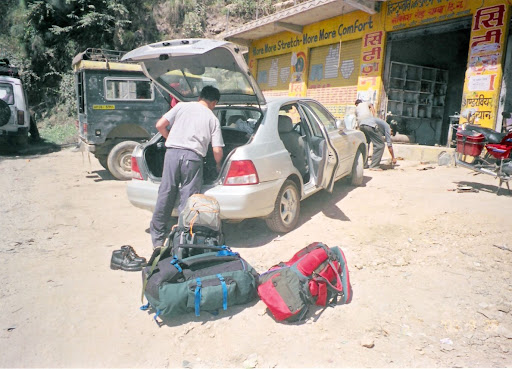 yre from an Alloy wheel and we would have to risk the drive till Chamba. After an anxious but comfortable drive and after some further frantic searching around we managed to locate the shop that would undertake the job of repairing my punctured tyre. By the time we left Chamba we were behind by two hours against our original schedule. By the time we reached Uttarkashi, we found out that the usual road is blocked due to an unexpected event. The mountain of Varanavat at whose feet sprawl the town of Uttarkashi, was having some inexplicable landslide from the top and sand, soil, rubble and uprooted trees were threatening to bury half of the town. The part of the town on the true right of the Bhagirathi had been evacuated, an alternate road opened on the other side of the river and the traditional route closed for motor traffic. This, however, did not cost us much time since we were warned beforehand by Harveer and he navigated us through. Rest of the drive was uneventful, but tiring. After picking up Chandan (My friend and proprietor of Crystal Adventure) from Uttarkashi, we finally reached Gangotri in the late and dark hours of the evening.
yre from an Alloy wheel and we would have to risk the drive till Chamba. After an anxious but comfortable drive and after some further frantic searching around we managed to locate the shop that would undertake the job of repairing my punctured tyre. By the time we left Chamba we were behind by two hours against our original schedule. By the time we reached Uttarkashi, we found out that the usual road is blocked due to an unexpected event. The mountain of Varanavat at whose feet sprawl the town of Uttarkashi, was having some inexplicable landslide from the top and sand, soil, rubble and uprooted trees were threatening to bury half of the town. The part of the town on the true right of the Bhagirathi had been evacuated, an alternate road opened on the other side of the river and the traditional route closed for motor traffic. This, however, did not cost us much time since we were warned beforehand by Harveer and he navigated us through. Rest of the drive was uneventful, but tiring. After picking up Chandan (My friend and proprietor of Crystal Adventure) from Uttarkashi, we finally reached Gangotri in the late and dark hours of the evening.
Gangotri and Beyond
This was almost end of the season and the town wore a deserted look. The stay was arranged at the Birla Niketan guest house and with the long drive behind us, we were now stretching our llimbs to get ready for the adventures ahead. For Pattu, it was the first experience of Garhwal and for Rupendra, the first experience of Bhagirathi. All three of us were trekking with each other for the first time. Pattu was the most silent one, quietly going about his things. We ended the day with a bit of a bonding session over drinks with Harveer and Chandan. Chandan was not going up with us; he would part ways there at Gangotri after ensuring that all arrangements are taken care of.
After the hustle and bustle next day morning we left for the day's destination Bhojwasa. Rupendra and Pattu had, by then, sampled the sumptuous fare coming out of the kitchen commanded by Pradeep and were all praises and expectant about the culinary treatment that waited ahead. Having offered the customary salutations at the temple and seeking blessings of Mother Ganga we proceeded ahead along the staircase leading o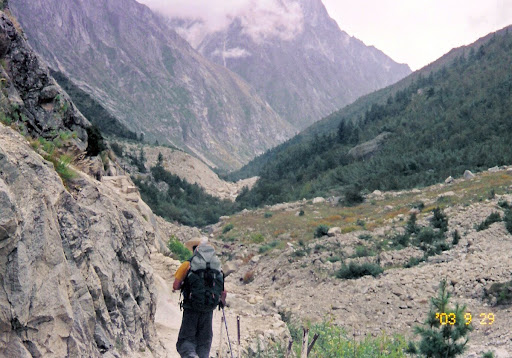 ut of the temple to the trail above. That's a tough welcome that the Gaumukh trail offers to the willing trekker right there at the very beginning. The route was familiar for me by then and I was thinking of the reasons why the trail would be as it is today. Clearly, the entire route offers several evidences of the fact that the Gangotri Glacier was indeed terminating at Gangotri at some point of time….the tell tale signs of the glacial remains in form of the rocks by the distant mountain sides..now covered with greenery, the soil, the rocks within the soil, the dried up remains of smaller glaciers that would have dried up ages ago, the easy gradient up the path and the wide river bed all tell the story that, Bhagirath, if ever there was a prince by that name, would have actually done his penance just beneath the ice mass of Gangotri glacier whose snout, those thousands of years ago, would have been at the place where Gangotri temple is located today. Obviously mythology adds its own spicy condiments to any story…but a rational explanation was perfectly plausible, even for the un-initiated into the theories of Geology. Rupendra and Pattu were obviously spell bound by the majestic vista that the trail offers and I was narrating a few stories here and there to them as well as into the microphone of my cam-corder all the while. The day was as sunny as it could have been in those days of late autumn..the greens at their peak and the snowy mountain tops reflecting the sun like giant mirrors. An occasional group of trekkers would pass by..most of them from West Bengal.
ut of the temple to the trail above. That's a tough welcome that the Gaumukh trail offers to the willing trekker right there at the very beginning. The route was familiar for me by then and I was thinking of the reasons why the trail would be as it is today. Clearly, the entire route offers several evidences of the fact that the Gangotri Glacier was indeed terminating at Gangotri at some point of time….the tell tale signs of the glacial remains in form of the rocks by the distant mountain sides..now covered with greenery, the soil, the rocks within the soil, the dried up remains of smaller glaciers that would have dried up ages ago, the easy gradient up the path and the wide river bed all tell the story that, Bhagirath, if ever there was a prince by that name, would have actually done his penance just beneath the ice mass of Gangotri glacier whose snout, those thousands of years ago, would have been at the place where Gangotri temple is located today. Obviously mythology adds its own spicy condiments to any story…but a rational explanation was perfectly plausible, even for the un-initiated into the theories of Geology. Rupendra and Pattu were obviously spell bound by the majestic vista that the trail offers and I was narrating a few stories here and there to them as well as into the microphone of my cam-corder all the while. The day was as sunny as it could have been in those days of late autumn..the greens at their peak and the snowy mountain tops reflecting the sun like giant mirrors. An occasional group of trekkers would pass by..most of them from West Bengal.
Finally one reached the rest-stop for the night ..at Bhojwasa. We were camping outside, no GMVN this time. By the time we reached the camping ground, our army of porters were already setting up the tents. Pradeep was well into his routine of pitching the kitchen tent and preparing that welcome drink- piping hot Masala tea for the three of us. I requested Harveer to arrange for some wood so we could set up a campfire, but he would not relent. He gave us a long spiel of the environmental hazard of burning wood and the tough Govt regulations regarding the issue prevailing at the place. The rest of the evening was spent listening to the gory tale of Harveer's escape from jaws of death in the Kalindikhal trail only couple of years back. It didn't help much to 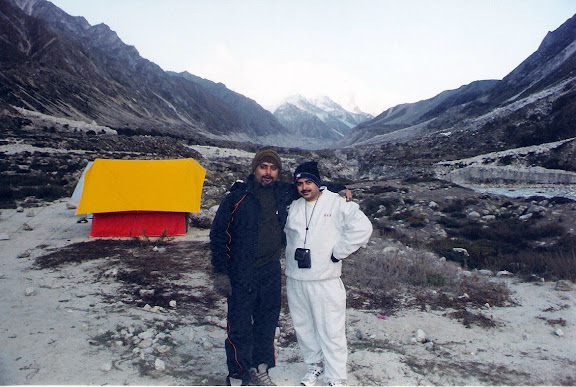 reduce our apprehension as to what was in store for us..cause we were going part of the way up that trail only..at least that was the objective. However, a steely determination was there in my mind this time…to achieve the objective and be back safe..at least go till Tapovan, which I had not been able to go to till then. I had never walked on a glacier before and with all that help by our side, I was raring to go.
reduce our apprehension as to what was in store for us..cause we were going part of the way up that trail only..at least that was the objective. However, a steely determination was there in my mind this time…to achieve the objective and be back safe..at least go till Tapovan, which I had not been able to go to till then. I had never walked on a glacier before and with all that help by our side, I was raring to go.
We started little late, the next day, knowing well that the total distance to be covered was relatively less at about 11 Kms of which 50% was easy walk. We had to bother only about the 5 Kms of route after Gaumukh which traversed the glacier and climbed up sharp to the bank on its true left. Since I had traversed the route earlier, I was poin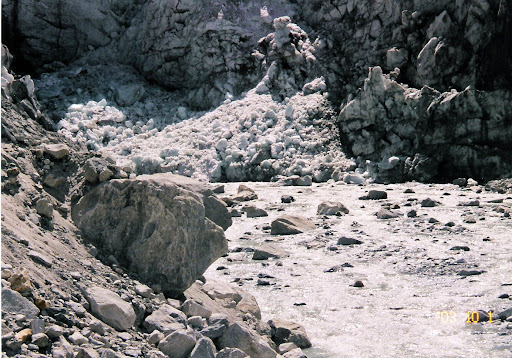 ting out to the amazing view of Tapovan, Bhrigupanth ridge and the Kedardome apart from the Bhagirathi sisters. I was personally eager to also show them the markings on the stone slabs that conclusively proved the rapid recession of the glacier. Both of them were as flabbergasted as I was when I had seen the enormity of the problem first time first hand. We reached Gaumukh by noon 1130Hrs ably guided by me…by then I had been to Gaumukh some three times in my vain attempts to go beyond to Tapovan. The weather gods were kind and we had the most peaceful half an hour of meditative rest there almost beneath the cascading icefall. All of us sprinkled some cold water fr
ting out to the amazing view of Tapovan, Bhrigupanth ridge and the Kedardome apart from the Bhagirathi sisters. I was personally eager to also show them the markings on the stone slabs that conclusively proved the rapid recession of the glacier. Both of them were as flabbergasted as I was when I had seen the enormity of the problem first time first hand. We reached Gaumukh by noon 1130Hrs ably guided by me…by then I had been to Gaumukh some three times in my vain attempts to go beyond to Tapovan. The weather gods were kind and we had the most peaceful half an hour of meditative rest there almost beneath the cascading icefall. All of us sprinkled some cold water fr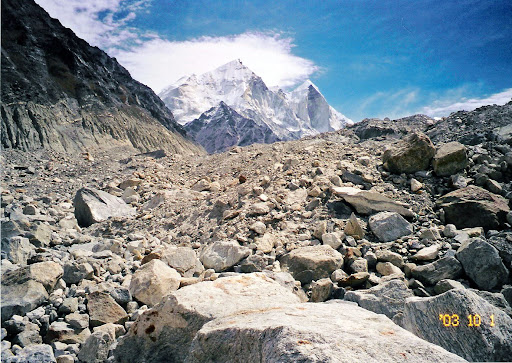 om the rapidly flowing stream as a token Ganga-snan. Harveer by that time was getting slightly restless about the timing and prodded us on to the sharply ascending trail towards the true right of the snout. We scrambled forth with renewed energy after that invigorating rest and water sprinkling. In about 15 minutes time we were on top of the icewall from where we could see the emergence of the Bhagirathi right underneath with gushing fury. Harveer warned us not to lean any further and to leave the place soon lest the rock-ice slab on which we were standing, gave way. We quickly scampered away to safety.
om the rapidly flowing stream as a token Ganga-snan. Harveer by that time was getting slightly restless about the timing and prodded us on to the sharply ascending trail towards the true right of the snout. We scrambled forth with renewed energy after that invigorating rest and water sprinkling. In about 15 minutes time we were on top of the icewall from where we could see the emergence of the Bhagirathi right underneath with gushing fury. Harveer warned us not to lean any further and to leave the place soon lest the rock-ice slab on which we were standing, gave way. We quickly scampered away to safety.
We had imagined 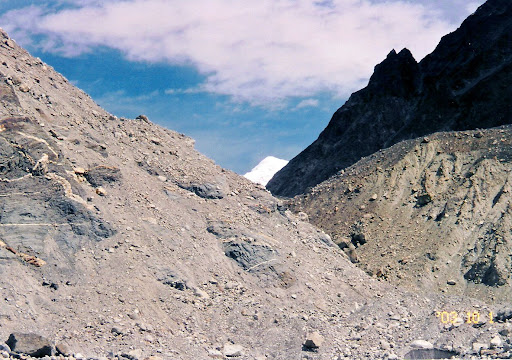 the glacier walk in our minds entirely differently, having traversed several smaller varieties of glaciers on treks in our myriad journeys in the Himalaya…one expected some dirty looking ice with lumps of roots and grass stuck onto it, which with some patience can be dug into and one could make some makeshift snow balls out of it. But nothing had prepared us for this! Kilometers of brown, dry, ugly looking rocks. The track looked as if going through the Wild west alongside the grand canyon. Only twice did Harveer stop us to point out two menacing ice walls jutting forth from the ground. They actually looked unnerving! The base of these walls was settled deep into the earth and rocks on which they stood. Little drops of water were dripping and creating a pool at the base. Soon we forgot the apparent dangers and toil of walking on a glacier. We had expected crevasses but we found none.
the glacier walk in our minds entirely differently, having traversed several smaller varieties of glaciers on treks in our myriad journeys in the Himalaya…one expected some dirty looking ice with lumps of roots and grass stuck onto it, which with some patience can be dug into and one could make some makeshift snow balls out of it. But nothing had prepared us for this! Kilometers of brown, dry, ugly looking rocks. The track looked as if going through the Wild west alongside the grand canyon. Only twice did Harveer stop us to point out two menacing ice walls jutting forth from the ground. They actually looked unnerving! The base of these walls was settled deep into the earth and rocks on which they stood. Little drops of water were dripping and creating a pool at the base. Soon we forgot the apparent dangers and toil of walking on a glacier. We had expected crevasses but we found none.

I was wondering how Harveer was able to navigate through this utterly hostile and unmarked terrain. But soon found the answer. He was basically navigating us from Cairn to Cairn. Some intrepid adventurer would have started the trek first that season and would setup a Cairn as a help for fellow travelers. The trick lied in identifying the cairn in thos zillions of rocks. Soon the snowy white tip of a mountain came into view up North to the true right of the glacier. It looked as if another valley or gully came and joined from far north. "That's the Raktavarn Glacier and the peak beyond is Sri Kailash..announced Harveer. This is the route one takes to the true rig ht of the river to explore the glacial sanctuary surrounded by the mighty peaks of Saife, Koteshwar, Thelu and Sudershan. The Bhagirathi sisters were bang ahead and the blazing sun overhead. The worn out mountain sides on both banks of the glacier indicated how high the glacier must have been in the not so distant past. The wear-out marks looked so fresh! A solid river can many a times be several times more powerful than its liquid counterpart when it comes to wear and tear!
ht of the river to explore the glacial sanctuary surrounded by the mighty peaks of Saife, Koteshwar, Thelu and Sudershan. The Bhagirathi sisters were bang ahead and the blazing sun overhead. The worn out mountain sides on both banks of the glacier indicated how high the glacier must have been in the not so distant past. The wear-out marks looked so fresh! A solid river can many a times be several times more powerful than its liquid counterpart when it comes to wear and tear!
Soon Harveer directed us to move our burden directly to the true left of the glaciers where we finally reached. From here the ascend up was almost a vertical climb up and it looked as if we have been sapped out of our last Calories. Up above a few people were shouting out at us not to climb since they were climbing down. The track that winds up is very narrow and a two way traffic would create a non-manageable traffic jam. The scale of the rise can be seen in the picture along side. It is a very faintly visible human figure in the highlighted circle at the end of the ar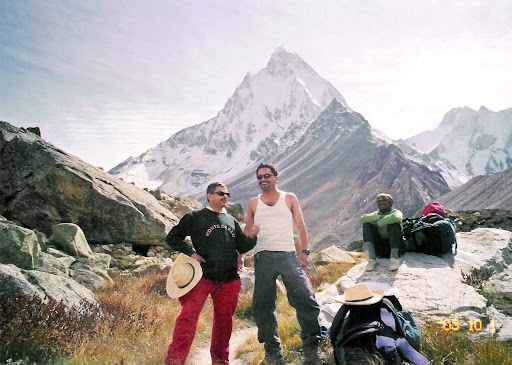 rowhead at the middle of the ridge. Just the view of the climb ahead took the wind out of us.
rowhead at the middle of the ridge. Just the view of the climb ahead took the wind out of us.
That's when a frustrated Rupendra took it out on me…
"Saale, aise route me tu recommend kar raha tha Shalini ko lane ke liye? Tera dimag kharab hai?"..Shalini is my friend's better half and prior to the journey he was seriously contemplating getting her along in the trip upon my approval.
"Mujhe kya pata tha…route thoda tough hai?" ..I blurted out. Honestly I had no idea there could be a tough stretch like that. Not that it was un-doable. But for a lady not too involved in the business of trekking, it can be a tough thing! At least Aditi, my wife would not have been able to do this..I thought.
"I don't think I will be able to do that without resting midway!" said Rupendra again, almost echoing my silent thoughts.
"Arre koi baat nahin saab…aram se ho jayega.." chipped in Harveer. "Ek ek kadam rakhiye..dhire dhire…20 minute ki baat hai bas!"
Pattu was watching all this with silent amusement. He was not the talking kind, I surmised.
Tapovan- Playground of the Gods
Anyways, we waited for the tourists up above to descend and waved them goodbye as they disappeared in the melee of rocks in the glacier. By the time the porters had also arrived. After f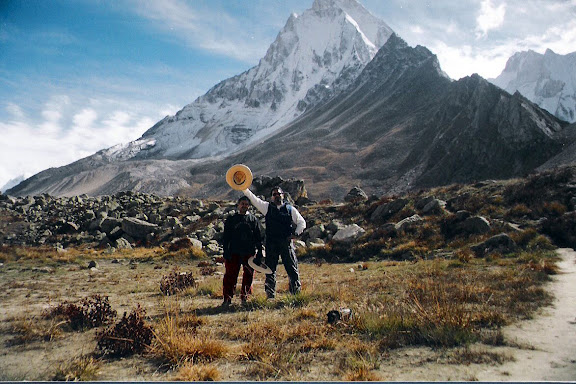 ew more gulps of water we finally decided to give the final push. I think the determination to reach Tapovan took me over, it was as if God was posing a final obstacle. Eyes focused on the trail at the heel of Harveer, who was walking ahead of me, I went forth, silently counting my breath and steps. Apparently the height was about 300 mtrs. It took us continuous 20 minutes of grueling climb to reach at the top finally. As I took the final step, a whole new world opened up. I had indeed reached the heavenly meadow where Yogis and Seers for ages have sought refuge to seek divinity, to peek into the limitless bounds of human mind under the shade of the mighty Shivling..away from the world..far from the madding crowd. The sprawling green meadow dotted with rocks here and there, the now dried morrains of the Meru Glacier, the swiftly flowing Akashganga (literally meaning- the Ganga from the heavens), the tall peaks all around in 360 degrees and the absolute blue sky dotted with tiny cumulous….one would feel for a moment what it would be in heavens. I and Harveer were the first to reach and we had to wait for the rest of the guys to arrive. It was getting progressively colder as the cardio vascular stress eased out. Ten minutes later both Rupendra and Pattu materialized from the trail. In a moment of elation I took off my shirt to celebrate arrival of the entire troupe! (I would repeat the trick in several more occasions at Mayali Pass, Bali Pass and Bamsarukhal Pass….stolen moments of boyish joy!)
ew more gulps of water we finally decided to give the final push. I think the determination to reach Tapovan took me over, it was as if God was posing a final obstacle. Eyes focused on the trail at the heel of Harveer, who was walking ahead of me, I went forth, silently counting my breath and steps. Apparently the height was about 300 mtrs. It took us continuous 20 minutes of grueling climb to reach at the top finally. As I took the final step, a whole new world opened up. I had indeed reached the heavenly meadow where Yogis and Seers for ages have sought refuge to seek divinity, to peek into the limitless bounds of human mind under the shade of the mighty Shivling..away from the world..far from the madding crowd. The sprawling green meadow dotted with rocks here and there, the now dried morrains of the Meru Glacier, the swiftly flowing Akashganga (literally meaning- the Ganga from the heavens), the tall peaks all around in 360 degrees and the absolute blue sky dotted with tiny cumulous….one would feel for a moment what it would be in heavens. I and Harveer were the first to reach and we had to wait for the rest of the guys to arrive. It was getting progressively colder as the cardio vascular stress eased out. Ten minutes later both Rupendra and Pattu materialized from the trail. In a moment of elation I took off my shirt to celebrate arrival of the entire troupe! (I would repeat the trick in several more occasions at Mayali Pass, Bali Pass and Bamsarukhal Pass….stolen moments of boyish joy!)
From a distance I noticed a lady clad in a simple saree walking towards us. I was quite taken aback for a moment when Harveer piped up
"Pranam Mataji!"..and whispered to me "Ye Bangali Mai hain"
I had no idea who Bangali Mai was, but she looked pretty much at home there clad in a simple saree with shawl draped over her.
"Kitne log ho? Koi tour party hai?" she was asking.
"Jee Haan..Vasuki Taal trek par hain. Baki saaman aur porter aa hi rahe hain" Harveer informed her. 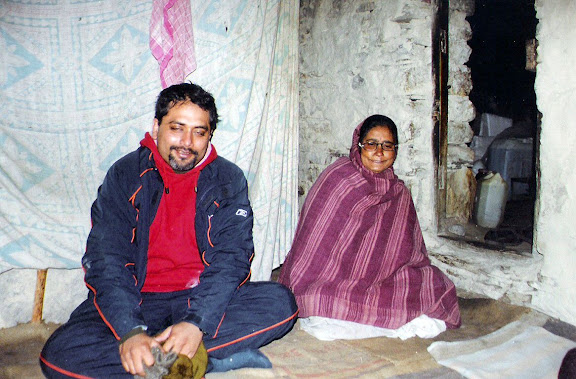
"Rehne khane ki vyvastha hai na? Koi zarurat pade to bolna"…the lady said. I was kind of taken aback. Of all the places on earth, here, miles and miles away from what we might call as civilization one suddenly felt at home. For somebody who wasn't as prepared as we were, that would have been manna from heavens!
Soon the lady walked away as mysteriously as she had appeared. Later on Harveer narrated her story. Apparently she was the widow of a Babaji who used to live nearby. In fact the Ashram is a stone hut with wooden roof, located just about 200 meters from where the trail rising up from Gangotri glacier enters Tapovan. I am told the trail changes course every year because of the dynamic nature of the glacier.
The Babaji was fondly called Bangali Baba. He had run away from his hometown somewhere in Bengal (Burdwan if I remember correctly) and had made this place his home. Years later, this lady, his wife joined him in. The couple used to live there happily for good many years till one fine day, few years back, probably around 1999, Bangali Baba passed away. Since then this lady, his widow has been carrying on the legacy - this Ashram. Later in the evening that day we visited her Ashram for a tete-tete. One is always curious to know, whenever one comes across such people, as to how they manage life in such terms, in conditions which one is inclined to believe are impossible! She fondly narrated about her life story. How she got married and had a seemingly normal family life with kids and all, how the Baba developed disinterest for that "normal" life after his first visit to the Himalayas, how he escaped from home and how she was devastated and how she finally managed to convince the Baba to bring her along with him. It made for a nice story. I also gathered in the process that Bangali Baba came to Tapovan at a pretty later period in his life, in his forties. He used to keep fine health until a fateful day when he succumbed to cardiac arrest.
For now we had to have our lunch. I felt slightly guilty, partaking of boiled egg as part of the packed lunch in such a spiritual ambience. But the hunger had the better of me. By the time we had finished lunch, it was beginning to feel chilly in all that swift wind even while sitting under the blazing afternoon sun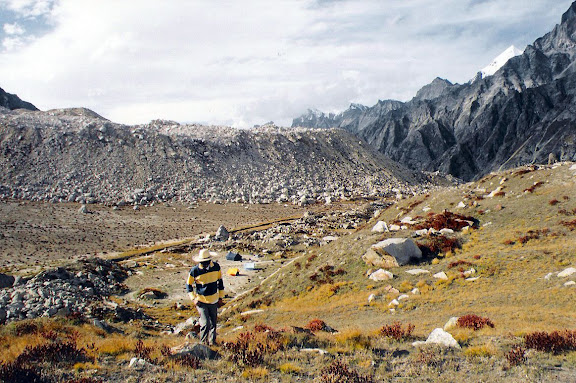 . It was already 1430 in the after noon and the team had to set up camp and prepare for the night stay. Off we went to look for the camping ground and we did discover one dream camp site surrounded by tall heaps of glacial rubble on all sides and an perfectly flat patch of land of the size of a hockey field! Having occupied the respective tents, unpacking and changing into evening gear we went about for a little sightseeing. We had a lot of time to kill. It wasn't even 4 o clock in the evening! I called out to Rupendra and Pattu to join me in a photoshoot, but they appeared dog tired.
. It was already 1430 in the after noon and the team had to set up camp and prepare for the night stay. Off we went to look for the camping ground and we did discover one dream camp site surrounded by tall heaps of glacial rubble on all sides and an perfectly flat patch of land of the size of a hockey field! Having occupied the respective tents, unpacking and changing into evening gear we went about for a little sightseeing. We had a lot of time to kill. It wasn't even 4 o clock in the evening! I called out to Rupendra and Pattu to join me in a photoshoot, but they appeared dog tired.
There was a little hillock sort of a rise right behind our campsite and I decided to set out exploring myself. Seeing me climbing up Rupendra soon joined the outing and Pattu followed suit not too long after. The hillock actually formed one of the high banks of the glacier. …it dropped ahead pretty steeply into the glacier floor. We essentially were standing on a natural balcony with the massive breathtaking view of the Gangotri Glacier. Right In front of us was the mountain that divides the Raktavarn and Chaturangi glacier (both tributaries o f Gangotri Glacier). At 2 O clock were the Bhagirathi Sisters (Bhagirathi I, II and III) with the sprawling meadow of Nandanvan at their feet and the confluence point of Chaturangi and Gangotri Glacier slightly to the left of Nandanvan. At 11 O clock direction one could see the body of the Raktavarn Glacier almost about 5 Kilometers back beyond its confluence with Gangotri glacier. One follows this glacier to explore the triple peaks of Saife, Thelu and Koteswar- all of them between 6000 to 6200 mtrs. At 10 O clock direction was what Harveer later explained as Black peak.
f Gangotri Glacier). At 2 O clock were the Bhagirathi Sisters (Bhagirathi I, II and III) with the sprawling meadow of Nandanvan at their feet and the confluence point of Chaturangi and Gangotri Glacier slightly to the left of Nandanvan. At 11 O clock direction one could see the body of the Raktavarn Glacier almost about 5 Kilometers back beyond its confluence with Gangotri glacier. One follows this glacier to explore the triple peaks of Saife, Thelu and Koteswar- all of them between 6000 to 6200 mtrs. At 10 O clock direction was what Harveer later explained as Black peak.
If one turned right and faced east wards Kedardome was right ahead with the massive expanse of the Gangotri Glacier to the left. Far away the peaks of Mandani Parvat and Chaukhamba wer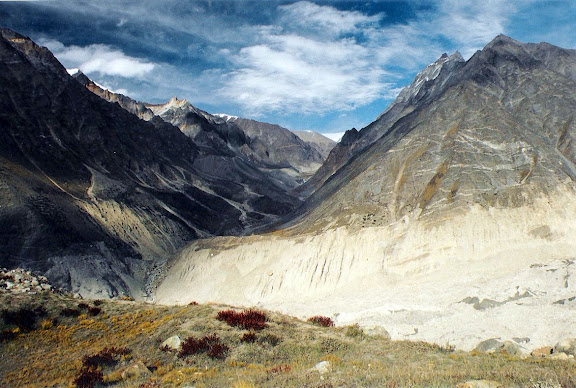 e visible. One would never be able to make out the distance to be a good 20 Kilometers. The Gangotri Glacier in fact originates from the western side of the Chaukhamba massif fed in by Swacchand Glacier first on its true right, The Kirti Glacier next on its true left ( just where the Tapovan meadow ends on the eastern extreme), The Chaturangi Glacier next on its true right, The Raktavarn Glacier next on its true right again and the now-dried Meru Glacier next on its true left. Chaturangi and Raktavarn are further fed by Shweta Glacier and Pitavarn Glacier respectively. This gigantic web of glaciers that spread over well nigh 500 Square kilometers and several meters thick solid ice give Birth to the Bhagirathi- Shiva's Matted loc
e visible. One would never be able to make out the distance to be a good 20 Kilometers. The Gangotri Glacier in fact originates from the western side of the Chaukhamba massif fed in by Swacchand Glacier first on its true right, The Kirti Glacier next on its true left ( just where the Tapovan meadow ends on the eastern extreme), The Chaturangi Glacier next on its true right, The Raktavarn Glacier next on its true right again and the now-dried Meru Glacier next on its true left. Chaturangi and Raktavarn are further fed by Shweta Glacier and Pitavarn Glacier respectively. This gigantic web of glaciers that spread over well nigh 500 Square kilometers and several meters thick solid ice give Birth to the Bhagirathi- Shiva's Matted loc ks indeed!
ks indeed!
If one looked right behind South wards from where we were standing, there was the tall Shivling looking over our little camp site. The mountain was so close, it created an illusion of a toy mountain, so very close to touch and feel, but back of our minds we knew that it's a 6000er…at least 1800 mtrs taller from the point where we stood. To the South West, a little to the right of Shivling (as we stand facing it) was the Meru Ridge. Aptly named because of its appearance, Meru in Sanskrit is Spine and this ridge appears exactly like the backbone of some huge animal.
One gets completely absorbed in a different world looking at the gigantic scale of things there…gigantic yet so very pretty…fearsome yet calm and serene. One then understands the importance of time and space. A physical space can indeed propel one's thought into realms surreal..Spiritual and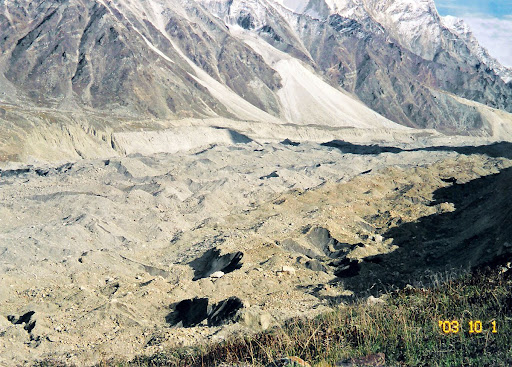 transcendental. One realizes the massiveness of God's scheme of things and the minuteness one's existence. The all important "I" crumbles to dust and the head bows in reverence. Seldom have I felt such awe and the abject feeling of surrender, the spirited wantonness of a child in the loving laps of nature.
transcendental. One realizes the massiveness of God's scheme of things and the minuteness one's existence. The all important "I" crumbles to dust and the head bows in reverence. Seldom have I felt such awe and the abject feeling of surrender, the spirited wantonness of a child in the loving laps of nature.
Just as we were lost, deep in our own thoughts, all three of us in their own worlds, the most funny thing happened. Presently we saw a group of school children coming up the same hillock with an adult as some sort of a guide. He definitely did not look like the school teacher, I would be mighty scared if he were, from what I saw happening next. Few of the curious children were asking this person as to what was the name of the mountain visible right in front, pointing his finger in the direction of the Bhagirathi Sisters. The man replied pretty confidently "Himalaya I, II and III." We were aghast for a moment and then burst out laughing internally. Part of me was actually infuriated with him because of the confi dent manner with which he took the poor children for a ride, while another part of me was mighty amused with the way he conducted himself with the children. I almost felt compelled to correct the mistake of such confident mis-christening of the grand mountains, but could not have done much actually.
dent manner with which he took the poor children for a ride, while another part of me was mighty amused with the way he conducted himself with the children. I almost felt compelled to correct the mistake of such confident mis-christening of the grand mountains, but could not have done much actually.
Not too long after we were terribly hungry and cold, the skies darkening slightly announcing the onset of twilight. The sure refuge was the kitchen tent at this moment where we were treated to some delicious chicken soup. There is this thing about the cook Pradeep…he would use the same packets of Knorr Soup but would add these pinches of condiment and spices that somehow amplify the taste several times …just what one would die for in that cold weather. For denizens of the arid plains, the cold of the night at 4500 meters in the month of October, can be "Shocking" to say the least. In the dimming twilight, listening to some more tales of fun and adventures as narrated by the ever so talkative Harveer, we suddenly spotted some Bharals not too far away from the camp site. The perky, alert guests of hours with their beautiful off-white and brown coat and pretty curved horns were peacefully grazing semi dried grass of the meadow about 200 mtrs away. The Nepali porters in the troupe were suddenly all attention. In fact one of the enterprising lads actually tiptoed his way to about 50 meters of their vicinity. He actually intended to hunt one with his Khukri!! Of course the flock was smarter than that and they scampered to safety at the slightest sound that came when the lad shifted position.
Dinner was served sharp at Eight and after some postprandial drinks we finally retired to our respective tents. I was worried that Pattu and Rupendra still looked worn out. There was also news from the Bengali trekkers we crossed on our way up that there was no water at Nandanvan. There was a base-camp set up at Nandanvan for a French team that was attempting Bhagirathi II which was already finding it hard to manage with the meager water resources there. We obviously couldn't take a chance! This basically meant that we could not shift our base to Nadanvan the next day. A visit to Vasuki Tal would require us to cross the breadth of the glacier twice in order to return to the camp, which would stay put at Tapovan only. In raw terms it meant an addition of 5 Kilometers of Glacier walk to our already planned itinerary. Tapovan – Vasukital- Tapovan would be a 24 kilometer trek, about half of which shall be across the Gangotri Glacier. It was going to be arduous no doubt!
Nandanvan and Chaturangi Bamak
The next day morning was glorious again- weatherwise. A perfect blue sky and blazing sun welcomed us in the morning. There is this peculiar thing about availability of water at Tapovan dur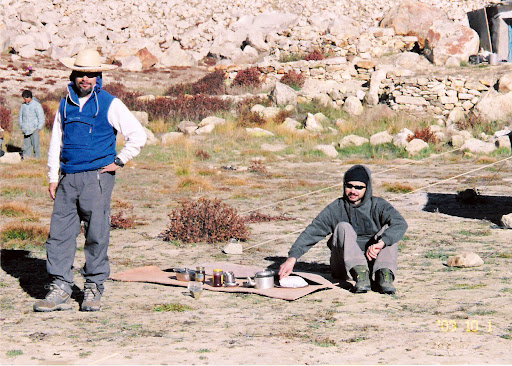 ing Spring and Late Autumn. The only source of water is a small stream that flows from the heights of Shivling. The water only flows when there is snow melt at the top. Thus the first flow of water starts at about Ten in the morning and continues till about 8 in the evening. Rest of the time the stream either remains frozen or dry…..beats the MCD water supply schedule in the city actually!! Suffice it to say that morning ablutions, if carried out before ten, would have to be managed without water or with stored water from the Kitchen tent.
ing Spring and Late Autumn. The only source of water is a small stream that flows from the heights of Shivling. The water only flows when there is snow melt at the top. Thus the first flow of water starts at about Ten in the morning and continues till about 8 in the evening. Rest of the time the stream either remains frozen or dry…..beats the MCD water supply schedule in the city actually!! Suffice it to say that morning ablutions, if carried out before ten, would have to be managed without water or with stored water from the Kitchen tent.
Afterwards while having breakfast in that sunny flat field in-front of the tents, we were planning out the days trek. It appeared that Pattu and Rupendra weren't quite interested in venturing into another 10 kilometers of Glacier walk and a total of 24 Kilometers of trek. They would stay back to explore the meadow more and may be try to seek audience with one of the many Babas that have their Ashram there. Harveer, another porter and I shall try ou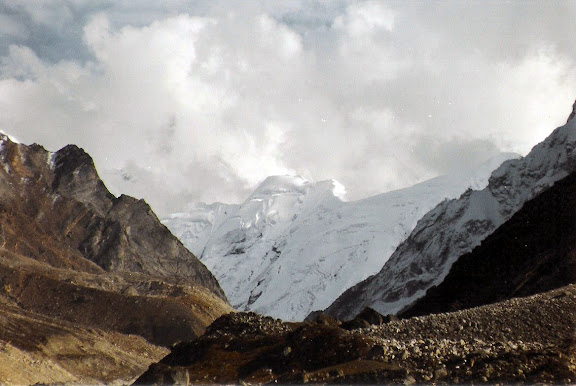 r luck at reaching Vasukital. Since the larger group was staying back, we would carry minimal supply of food, water, camera and energy drinks in a day pack and gun for a fast trek onwards and back.
r luck at reaching Vasukital. Since the larger group was staying back, we would carry minimal supply of food, water, camera and energy drinks in a day pack and gun for a fast trek onwards and back.
We set off for the day's trek by 0900 Hrs in the hope that we shall be able to make it back by 1700. There was no trail to follow, except for a small distance in the Tapovan meadow in the general direction eastwards along the Gangotri Glacier's true left. Then suddenly Harveer took a turn Northwards into the Glacier basin along a steep bank down..it was as if he smelt the trail out of thin air. Pretty soon we were into glacier walking up and down along those numerous little mounds of earth, rock and ice. It was an un-ending battle that frustrated me no end. The mounds were not taller nor deeper than fifty feet, but they would just not end! After about an hour, we were still in the middle of the glacier.
The view was however spectacular. As one faced down stream, one could see Bhojwasa at the far distance in the west, at 12 O clock direction, South-West-West at the 11 O clock dir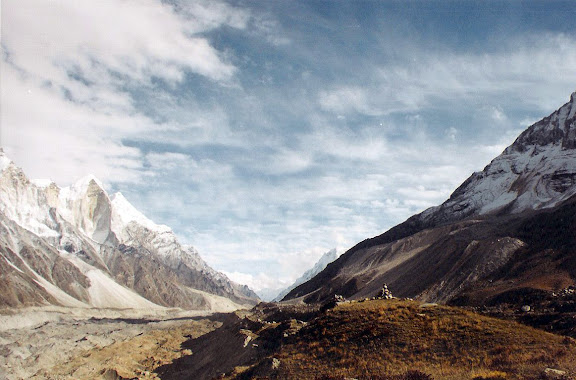 ection was the tall ridge of Bhrigupanth that looked a pristine white. At South-south-west in the 10 O clock direction was Meru Ridge and a hint of Thalaysagar (Also called Sphatikling- Pithwara), onto the South at 9 O Clock direction was the majestic Shivling, slightly to the back at 8 O Clock was Kirti Stambh South-south-East, at 7 O clock were Kedardome and Kharachkund. Looking back at East, at 6 O clock would be Chaukhamba and Mandani, at 4 O Clock – North- Easterly direction were Bhagirathi Sisters beaconing us. One could see Koteswar and Thelu in the North Westerly direction towards 2 O Clock directions. About hundred feet away was a tall black wall of ice with a large rock precariously hanging from the top of it. These are the icewalls that you see at Shweta Glacier on the Kalindikhal route, informed Harveer. There were the occasi
ection was the tall ridge of Bhrigupanth that looked a pristine white. At South-south-west in the 10 O clock direction was Meru Ridge and a hint of Thalaysagar (Also called Sphatikling- Pithwara), onto the South at 9 O Clock direction was the majestic Shivling, slightly to the back at 8 O Clock was Kirti Stambh South-south-East, at 7 O clock were Kedardome and Kharachkund. Looking back at East, at 6 O clock would be Chaukhamba and Mandani, at 4 O Clock – North- Easterly direction were Bhagirathi Sisters beaconing us. One could see Koteswar and Thelu in the North Westerly direction towards 2 O Clock directions. About hundred feet away was a tall black wall of ice with a large rock precariously hanging from the top of it. These are the icewalls that you see at Shweta Glacier on the Kalindikhal route, informed Harveer. There were the occasi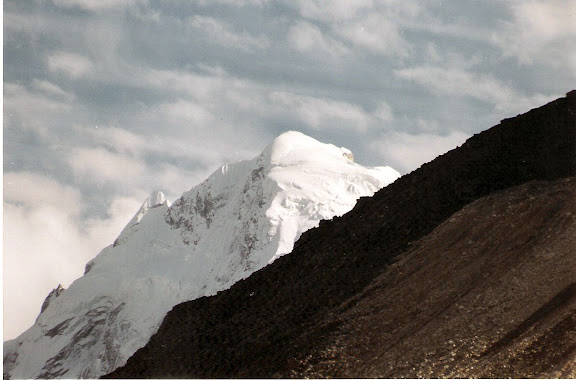 onal crevasses that Harveer would guide me around. Finally one reached the right bank of the Gangotri glacier where a sharp rise takes one to the top over to the Nadanvan meadow…somewhat similar to the tough 300 mtrs rise we had negotiated the previous day approaching Tapovan. After huffing and puffing through it for forty minutes I concluded that it was tougher than the one we did the previous day.
onal crevasses that Harveer would guide me around. Finally one reached the right bank of the Gangotri glacier where a sharp rise takes one to the top over to the Nadanvan meadow…somewhat similar to the tough 300 mtrs rise we had negotiated the previous day approaching Tapovan. After huffing and puffing through it for forty minutes I concluded that it was tougher than the one we did the previous day.
Nandanvan is decidedly as pretty if not prettier than Tapovan. The geography is pretty similar, meadow at the feet of a giant mountain…the mountain in this case being the Grand Bhagirathi II. We could see the blue outline of the large tent of the purported base camp we had heard about earlier- the French expedition. We approached the base camp only to find that the members therein were fairly non-communicative. Probably the long stay out there and the water problem had got the better of their moods. That's when Harveer turned on his transistor radio and to my surprise tuned into Times FM which was as clear as what one would hear at Pitampura in Delhi!! Apparently the tall valley that we were in had a line of sight connectivity with Delhi for FM radio waves.
We had to set forth, we had no luxury of time. Another 2 kilometers of almost flat terrain brought us to Upper Nadanvan where we found a tiny trickle of a stream. We thanked our stars for havi ng taken the right decision of not shifting camp. Harveer pointed out at a hut-like shelter where he had taken refuge during his escape from the Snow storm at Kalindikhal route the year before. The path rises up to the high bank of Chaturangi Bamak after that, a chilly, windy yet most breath taking trail. Walking that path, looking down at the Chaturangi glacier few hundred feet below I realized the significance of ancient nomenclature of the glaciers. The Chaturangi Glacier, even today, looks like a multi colored glacier with a clear demarcation of colors in the middle. Slightly yellowish towards the true left and slightly darker towards the true right. I assumed, the rest of the names would also have similar significance…Raktavarn(Blood Red), Pitavarn(Yellow), Shweta(White) etc.
ng taken the right decision of not shifting camp. Harveer pointed out at a hut-like shelter where he had taken refuge during his escape from the Snow storm at Kalindikhal route the year before. The path rises up to the high bank of Chaturangi Bamak after that, a chilly, windy yet most breath taking trail. Walking that path, looking down at the Chaturangi glacier few hundred feet below I realized the significance of ancient nomenclature of the glaciers. The Chaturangi Glacier, even today, looks like a multi colored glacier with a clear demarcation of colors in the middle. Slightly yellowish towards the true left and slightly darker towards the true right. I assumed, the rest of the names would also have similar significance…Raktavarn(Blood Red), Pitavarn(Yellow), Shweta(White) etc.
Presently I saw a human figure hurrying down towards us along the ridge…looked like an European trekker. When we met, we shook hands and had some quick introductions. From his accent I suspected he was of Spanish origin. When I asked, if he was indeed from Spain, he informed me he was Basque, not Spanish. "We are not the only ones having a Kashmir problem…" I went on explaining to Harveer, how Basques were to the Spanish what Kashmiris and Nagas are to India. Yonder at a distance, Shivling was appearing like a Mahayogi lost in deep meditation. The straight line distance was 9 kilometers, I estimated, but it looked as if one could reach out and touch it. To our left a sloping ridge led to the top of the Bhagirathi II. That's the approach route to the summit, Harveer told me, pointing towards the approximate location of camp I.
The long ridge walk seemed unending and we were now in-front of the Vasuki Parvat- the mythical snake with the thousand hoods. The top of the mountain actually resembled the shape one has seen in Amar Chitra Katha. By now, it was 1430 and we could see wisps of cloud gathering in the sky. Vasuki Taal was near enough..at about 2 Kilometeres on the outer side. But that would mean adding another hour before starting back for Tapovan and that would be stretching things too far. We decided to have lunch and turn back from there. The last thing that we wanted was getting stuck in a snow storm in the middle of the glacier on the way back. Even though the sun was bearing down upon us with all fury, the food was frozen hard! The Puris were like Papads.
Finishing a final photoshoot we hurried our way back to retrace till Nadanvan by 1530. Just as we were beginning to hurry down the slope into the glacier at Nandanvan, we saw another herd of Bharals …a large herd indeed…probably 25/30 in number. A large bull of a Bharal with his twisted horns almost glared at us before he commanded his team to safety. The large herd vanished almost magically in a matter of seconds beyond another rock and a slope….these are some of the most agile creatures that I have seen on the crazy Himalayan slopes. Only rarely does any one of these surefooted animals ever succumb to an accidental fall.
Toiling our way through the glacier with the fear or clouds and darkness was another experience. The limbs would not wish to take one more step, but the thin line dividing wonder and danger would prod us on. Once I almost crushed my legs under a large boulder but thankfully evaded myself in time…the loose boulder was about to smash my left leg into a crevasse! By the time we were nearing the left bank (Tapovan Bank) we saw a lone trekker in the middle of the glacier, looking around for route…obviously lost. Harveer called out and communicated something in sign language…which he seemed to understand. "How on earth do people dare to do such acts? What would it be to get lost in the middle of this huge expanse of rock, ice and crevasses with no defined route, the low grumble of the mass of ice forever audible!" I mused to myself.
It was dark by the time we hit the camp. Pattu and Rupendra we re all ears to hear about the day's exploits and also probably a bit disappointed that they had given in to tireness in the morning. Luckily I had some footage captured in the camera which they saw eagerly. They in the meanwhile had explored the Tapovan to their heart's content. So they narrated their stories about the encounter with the Baba with the solar stove who lived by the stream that flows through what remains of the Meru Glacier. Also their excursion to the glacial lake en route the Camp I of Shivling along the Noth Face and also the attempt at climbing the now-dried-up body...the morrain of the Meru glacier. Later on I learnt about another possible exploration to Neel Tal. Next day we were to leave for Bhojwasa and the next day back to Harshil after which we would leave for Delhi.
re all ears to hear about the day's exploits and also probably a bit disappointed that they had given in to tireness in the morning. Luckily I had some footage captured in the camera which they saw eagerly. They in the meanwhile had explored the Tapovan to their heart's content. So they narrated their stories about the encounter with the Baba with the solar stove who lived by the stream that flows through what remains of the Meru Glacier. Also their excursion to the glacial lake en route the Camp I of Shivling along the Noth Face and also the attempt at climbing the now-dried-up body...the morrain of the Meru glacier. Later on I learnt about another possible exploration to Neel Tal. Next day we were to leave for Bhojwasa and the next day back to Harshil after which we would leave for Delhi.
Melancholic Steps Back
The trek back to Bhojwasa involved some impromptu training sessions by Harveer about how to negotiate a slope downwards.
"Heels ko pehle rakhiye ground me dig kariye sir….aur apna weight Kamar pe lijiye, na ki ghutno pe"…he was explaining. He took the example of the gait of a pahadi woman carrying a load on her back and how she uses her waist and hip-bone and not the knee to bear the load. All of us were eager students. We were so scared of climbing down that slope that we actually practiced for 15 minutes before attempting the climb down.

After a brief stopover at Gaumukh again we hurried back to Bhojwasa and were there by 1300 Hrs!! We had the whole day to spare!
There is a large rock almost on the right bank of the Bhagirathi river, just about 100 meters away from the camp site at Bhojwasa. It was a different experience lazing there on the rock, one whole sunny afternoon with our wide brimmed hat over the face as a sun shade. I must have dozed off for a couple of hours when it started to be chilly and I got up to see Rupendra doing exactly the same…lazing on another part of the rock. We noticed a tent structure not too far away near the "Glacial Melt Monitoring Station" – the wooden cabin that I had been noticing for three years now. Curious, we went up to explore what it was all about.
We met a lanky looking gentleman collecting his dried towel from the cloth line. After brief introduction we came to know that he was a geologist and part of the team that was stationed there as a part of some joint initiative of Government of India and the UN.
"What do you do here exactly and what exactly is this business of glacial melt monitoring? For what purpose?", we enquired.
"We do exactly as it says, monitor the quality of sediments and deposits that come with the melt water in the Bhagirathi."- he said. "Usually it helps us to understand the phenomenon of glacial melting better. We also measure such things as melting rate."
"What is the summary of your study so far? " – we wanted to understand the whole thing in a layman's terms.
"What we have found so far is that right now the rate of melting is at an all time high and is expected to be so for several years to come. Currently the glacier is receding at about 23 meters per year." He replied, matter-of-factly.
"23 Meters?!"- I did a quick calculation "Assuming, the glacier to be 23 Kilometers long, the glacier would vanish in 1000 Years!" I exclaimed
"First of all, the glacier is no longer 23 Kilometers long and second, the rate of melt is increasing..in the next 5 years we expect it to increase to 25 meters per year! In our estimate, the glacier shall cease to exist in the next 60 years or so!" added the Geologist. "In a geological time scale, it's the last breaths of this mighty glacier" he was explaining.
" The Meru Glacier that you would have seen to your right on your way up is dried as of today. In fact, by 1000 AD, around the time of Adi Shankara, the glacier snout was about 4 Kilometers away from Bhojwasa near that wide bend where there is a Bhoj nursery now. The landmark there is the rivulet that you see just after that coming from the mountains on the right bank. At that time this rivulet also used to be a small glacier. Today the glacier snout is a good 2 Kilometers away from that place." He went on.
"Why is this happening? Is it because of all the tourists and pilgrims? And all the dirt and plastic that we bring with us?" I asked
" All the dirt and plastic and a few thousand pilgrims can't alter things at this scale. Geological timescales are incomprehensible to a normal mind. Do you know how old that mountain is ?" He asked ..pointing towards the mountain that overshadows the Bhojwasa valley.
"May be a thousand years? 4000 years?"..I hazarded a guess.
"Well that mountain is young…its about 20000 years old"- he said …or some such humungous number.
"The scale of things in nature and geology are truly astounding. This phenomenon that you are seeing in Varanavat mountains is known to you because it has happened too close to human habitation. We see these happening at Satopanth Glacier and Bhriguparbat for ages now. Geology has its own scheme of things, its own ways of change. What you and I do can impact it but by a very minute extent"..I was getting my rudimentary lessons of Geology.
"In fact across the world this is happening ..In the European Alps, In the Arctic, The Andes, The Kilimanjaro, Antarctica…every where we are seeing a gigantic geological process at work. Glaciers across the world are receding. The current theory is that we are at the ebb of the cycle of ice age. ..a process which repeats every ten thousand years approximately. In every such cycle, world over there is a massive deposition of snow that creates the glaciers which then melts and recedes away till another deluge of snowfalls come. When all the snow melts, we see a global rise of sea levels. Just that, this time around…its happening possibly a mite too fast for our comfort." He explained.
I was sad. I was sad that this beautiful place would be devoid of its natural treasure so soon?! Probably in my own lifetime or my that of my child's! After such a soul touching experience at that paradise of a place, I came back with this haunting thought of what was in store for the generations to come…all the way to Delhi.
I would further see that seminal work of Al Gore in "An Inconvenient Truth"- loudly bringing back memories of that fateful evening at Bhojwasa. I would see years later the comparison of photographs of Pindari Glacier- of the one I had taken in 1991 and the o ne my colleague Mita Brahma took in 2007…..the snout of the glacier had vanished! I would hear years later from Chandan that a huge crack has appeared in the Gangotri Glacier and the route to Tapovan has become much more circuitous. As the years have gone by, I have noticed the slow yet steady increase of information and discussion around the issue..in India ad across the world. All those moments I have remembered th doomsday prophecy of that young Geologist. My sensitivity for eco-protection of Himalayas increased several times after that conversation…I have even thought of an awareness campaign by way of educating people by showing them the very evidence of this phenomena..may be through a guided tour! ..but to what end? Will the celestial gift for this greatest of civilizations really wither away into pages of history? Reminds one of the long dead and died courses of the Holy river Saraswati which was so intertwined with the Vedic Civilisaton... One wonders what little thing one can do…some small yet determined help ..to preserve this divine legacy of God Almighty?
ne my colleague Mita Brahma took in 2007…..the snout of the glacier had vanished! I would hear years later from Chandan that a huge crack has appeared in the Gangotri Glacier and the route to Tapovan has become much more circuitous. As the years have gone by, I have noticed the slow yet steady increase of information and discussion around the issue..in India ad across the world. All those moments I have remembered th doomsday prophecy of that young Geologist. My sensitivity for eco-protection of Himalayas increased several times after that conversation…I have even thought of an awareness campaign by way of educating people by showing them the very evidence of this phenomena..may be through a guided tour! ..but to what end? Will the celestial gift for this greatest of civilizations really wither away into pages of history? Reminds one of the long dead and died courses of the Holy river Saraswati which was so intertwined with the Vedic Civilisaton... One wonders what little thing one can do…some small yet determined help ..to preserve this divine legacy of God Almighty?


























